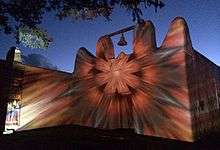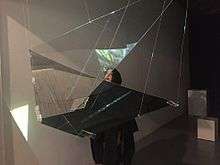Nettrice Gaskins
| Nettrice R. Gaskins | |
|---|---|
 | |
| Born |
September 25, 1970 Baltimore, Maryland, |
| Nationality | American |
| Education | BFA from Pratt Institute, MFA from School of the Art Institute of Chicago, PhD from Georgia Institute of Technology |
| Known for | Art & Technology |
| Website | nettrice.us |

Nettrice R. Gaskins (born 1970) is an African American digital artist, academic, cultural critic and advocate of STEAM fields. In her work she explores "techno-vernacular creativity" and Afrofuturism.[1][2]
Education
Gaskins was born in Baltimore MD. At DuPont Manual High School Gaskins once painted a mural of parabolic functions in her math class and created computer art illustrating the connection of contemporary door-knocker earrings to traditional Ghanaian accessories. She was engaged, at even that early an age, with the intersection of art and science. That work led the way to her acceptance to Pratt Institute in Brooklyn where she earned her BFA in 1992.[2]
In 1994 she received her MFA in Art and Technology from School of the Art Institute of Chicago. After working for a number of years in K–12 and post-secondary education, community media and technology, Gaskins received a doctorate in Digital Media from Georgia Tech in 2014.[3][4] Her thesis started with making the connections of graffiti and math.[1]
In 2014 she became director of the STEAM Lab at Boston Art Academy which serves forty percent Black and forty percent Latino high-school students.[1] As of 2018, Gaskins is a program manager at the Fab Foundation,[4] a Boston-based nonprofit.
Career

Gaskins investigates humans versus nature, sound versus imagery.[3] She wants people of color to be able to see themselves in computing and digital technology fields.[5] She is known for her STEAM work, arguing that adding Art to the traditional Science, Technology, Engineering and Math education will open more opportunity for students of color. She believes that STEM has always existed within groups that are not traditionally part of the mainstream discourse, and through the arts (like hip-hop, film, dance, theater, video games and visual art) people may be realize that these groups were always part of the conversation. She is inspired by the “entrepreneurial spirit," as she calls it, as a way to progress, visible in such ingenious pioneers as Fred Eversley, John Coltrane, Sun Ra, George Clinton and Grandmaster Flash who adapted the currently used cross-fader from reclaimed electronics.[1][2]
Her work creates spaces that respond to culture, within a culture, thus become a catalysts for change inside communities, instead of being in the control of others.[6]
Dr. Gaskins' digital installation, AR Virtual Sounding Space, using both physical computing and projection mapping, was the 2015 feature of Paseo Pop Up, a festival produced by Paseo Projects in Taos, New Mexico. It was a digital projection on the Luna Chapel at the Couse-Sharp Historic Site. The immersive projected piece was inspired by cosmograms, culturally based maps of space and time like the medicine wheel. The public then could effect the piece through gloves that control sound and color of the projection. As part of this engagement she was one of a few artists with engagements in Electrofunk Mixtape: A Virtual Sounding Space, a workshop with local students.[3] She performed Electrofunk Mixtape: Illuminus Edition with Hank Shocklee in Boston, MA as part of the Illuminus outdoor festival.[7]
In 2018 Gaskins was in the group exhibition, Probability & Uncertainty at Union College's Mandeville Gallery in Schenectady, NY.[8] "Afrofuturism Amplified in Three Dimensions" included a lecture and maker workshop. In the show, Gaskins was one of six women artists working with scientific themes. She also presented at the National Art Education Association in Seattle, WA, in Barcelona as part of STEAMConf 2018[9] and in Madrid as part of International Girls in ICT Day.
In 2017 Gaskins was in the group exhibition, We Have Always Lived in the Future at Flux Factory in Long Island City, NY. This show was mentioned in Art in America, specifically how her work "presents opportunities for rousing transcendence."[10]
In 2014 Gaskins spoke at a symposium called “Afrofuturism in Black Theology: Race, Gender, Sexuality and the State of Black Religion in the Black Metropolis" featuring George Clinton at Vanderbilt University.[11] She spoke at a symposium called “Why Comix? Drawing the World You Want to See” about representation in comics at Northwestern University and on a panel called the Aesthetic Architecture Symposium titled "The Aesthetics of Activism: Afro-Futurism, Xenofeminism and Disobedient Objects" at Yale University in 2016.[12][13]
Gaskins is also known for her cultural criticism, including the unpacking of Beyonce's Formation video at the intersection of contemporary police killings of black boys and the story of traditional voudoo spirit, Ghede Nibo.[14]
Publications
- Gaskins, Nettrice. "Mama Wata Remixed: The Mermaid in Contemporary African-American Culture." In Scaled for Success: The Internationalisation of the Mermaid. East Barnet, UK: John Libbey Publishing, 2018.
- Gaskins, Nettrice. "Why Black Panther's Shuri Is So Important To Young Black Girls and Maker Culture" SyFy Wired. (21 Feb 2018)[15]
- Gaskins, Nettrice. "Deep Sea Dwellers: Drexciya and the Sonic Third Space." Shima: The International Journal of Research into Island Cultures 10, no. 2 (2016). doi:10.21463/shima.10.2.08.
- Gaskins, Nettrice. "How Art and Dance Are Making Computer Science Culturally Relevant" EdSurge. (26 Jul 2016)[16]
- Gaskins, Nettrice. "Marvel's Black Panther Makes STEAM Relevant to Under Represented Youth; Plus, VR's Century-Old Roots" EdSurge. (5 Jul 2016)[17]
- Gaskins, Nettrice. "Afrofuturism on Web 3.0: Vernacular Cartography and Augmented Space." In Afrofuturism 2.0: The Rise of Astroblackness. Lanham, MA: Lexington Books, 2016.
- Gaskins, Nettrice. "The African Cosmogram Matrix in Contemporary Art and Culture." Black Theology 14, no. 1 (2016): 28-42. doi:10.1080/14769948.2015.1131502.
- Gaskins, Nettrice. "Re-Creating Niobe: The Construction and Re-Construction of Black Femininity through Games and the Social Psychology of the Avatar." In Future Texts: Subversive Performance and Feminist Bodies. Anderson, SC: Parlor Press, 2016.
- Gaskins, Nettrice. "Welcome to Afrofuturism 3.0" Slate. (2 Dec 2015)[18]
- Gaskins, Nettrice. "Deconstructing the unisphere: hip-hop on a shrinking globe in an expanding universe." In Meet Me At the Fair , 155-64. Pittsburg, PA: ETC Press, 2014.
- Gaskins, Nettrice. "Advancing STEM Through Culturally Situated Arts-Based Learning." Journal of the New Media Caucus 9, no. 1 (Spring 2013).
References
- 1 2 3 4 Lewontin, Max (2015-12-16). "How efforts to combine arts with STEM education could improve tech diversity". Christian Science Monitor. ISSN 0882-7729. Retrieved 2017-04-21.
- 1 2 3 Staff, Blerds (2014-10-09). "Using STEAM to Move Marginalized Students into the Future: An Interview with Dr. Nettrice Gaskins". Blerds. Retrieved 2017-04-22.
- 1 2 3 "The Paseo promotes youth participation". The Taos News. Retrieved 2017-04-22.
- 1 2 "Fab Foundation – About Fab Foundation". fabfoundation.org. Retrieved 2018-08-18.
- ↑ Shein, Esther. "Computing the Arts | April 2017 | Communications of the ACM". cacm.acm.org. Retrieved 2017-06-26.
- ↑ "Making for All: How to Build an Inclusive Makerspace (EdSurge News)". EdSurge. 2015-05-10. Retrieved 2017-04-23.
- ↑ "The Electrofunk Mixtape: Illuminus Edition". Illuminus. Retrieved 2017-06-25.
- ↑ "Probability & Uncertainty | Mandeville Gallery". muse.union.edu. Retrieved 2018-08-18.
- ↑ "Steamconf 2018 – 4th. International Education Conference". 2018.steamconf.com (in Catalan). Retrieved 2018-08-18.
- ↑ "Future Perfect: Flux Factory's Intersectional Approach to Technology - News - Art in America". www.artinamericamagazine.com. Retrieved 2017-05-09.
- ↑ Owens, Ann Marie Deer. "Musician George Clinton part of Vanderbilt black theology event". Vanderbilt University. Retrieved 2017-04-23.
- ↑ "Blerdwatch: "It's A Great Time To Be A Person Of Color In Comics"". Bleeding Cool Comic Book, Movie, TV News. 2016-01-15. Retrieved 2017-04-23.
- ↑ "Aesthetic Activism - Announcements - e-flux". www.e-flux.com. Retrieved 2017-04-23.
- ↑ Bradley, Regina N. (2016-02-12). "Getting in Line: Working Through Beyonce's 'Formation'". Huffington Post. Retrieved 2017-04-23.
- ↑ Gaskins, Nettrice (2018-02-21). "Why Black Panther's Shuri is so important to young black girls and maker culture". Syfy. Retrieved 2018-09-13.
- ↑ "How Art and Dance Are Making Computer Science Culturally Relevant (EdSurge News)". EdSurge. 2016-07-26. Retrieved 2017-04-21.
- ↑ "Marvel's Black Panther Makes STEAM Relevant to Under Represented Youth; Plus, VR's Century Old Roots (EdSurge News)". EdSurge. 2016-07-05. Retrieved 2017-04-21.
- ↑ Gaskins, Nettrice (2015-12-02). "Welcome to Afrofuturism 3.0". Slate. ISSN 1091-2339. Retrieved 2017-04-21.